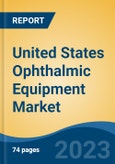Speak directly to the analyst to clarify any post sales queries you may have.
10% Free customizationThis report comes with 10% free customization, enabling you to add data that meets your specific business needs.
The branch of medicine and surgery that deals with visionary defects and diseases along with the diagnosing and treatment of eye disorders are coined as ophthalmology. The devices, and medical equipment used in the diagnosing and treatment procedures in ophthalmology, are the ophthalmology equipment. It encircles all sorts of tools, from the diagnosing device, ophthalmometer, eye-sight correcting contact lenses, phoropter, and tonometer, all belonging to the ophthalmic equipment criteria.
The United States ophthalmic equipment market segmentation is based on product, application, end-user, competitional landscape, and regional distribution. Based on product, the market is further bifurcated into vision care products, ophthalmology surgical devices, diagnostic & monitoring devices, and others. Ophthalmology surgical devices are anticipated to hold the largest revenue shares of the market in the next five years, on the account of increasing instances of eye diseases that require the surgical procedure as a treatment process. Diseases like cataracts, glaucoma, refractive errors, and diabetic retinopathy are propelling the growth of the surgical devices market. Moreover, diagnostic and monitoring devices are also anticipated to register significant shares of the market due to the post-op processes and pre-op diagnosing procedures.
A partial list of market players in the United States ophthalmic equipment market includes Alcon Inc., Johnson & Johnson, CooperVision, Inc., Bausch Health Companies, Inc, Carl Zeiss, Inc., Glaukos Corporation, STAAR Surgical Company, Heidelberg Engineering, Inc., Canon Inc., Optovue, Inc, among others. These market players hold larger shares of the market than the new market players. With the advancement of technology, it is appropriate to say that the effective research and development of technologically advanced medical devices would support market growth and benefit the market players as well as the consumers. New market players may focus on research and development to provide devices that satisfy consumer demand as well as benefits the market players in building their brand value. Other competitive strategies include mergers & acquisitions and new product developments.
The objective of the Study:
- To analyze the historical growth of the market size of the United States Ophthalmic Equipment market from 2017 to 2020.
- To estimate and forecast the market size of the United States ophthalmic equipment market from 2021 to 2027 and the growth rate until 2027.
- To classify and forecast the United States ophthalmic equipment market based on product, application, end-user, competitional landscape, and regional distribution.
- To identify the dominant region or segment in the United States ophthalmic equipment market.
- To identify drivers and challenges for the United States ophthalmic equipment market.
- To examine competitive developments such as expansions, new product launches, mergers & acquisitions, etc., in the United States ophthalmic equipment market.
- To identify and analyze the profile of leading players operating in the United States ophthalmic equipment market.
- To identify key sustainable strategies adopted by market players in the United States ophthalmic equipment market.
The publisher calculated the market size of the United States ophthalmic equipment market using a bottom-up approach, wherein data for various end-user segments were recorded and forecasted for the future years. The publisher sourced these values from industry experts and company representatives and externally validated them by analyzing historical data of these product types and applications for getting an appropriate, overall market size. Various secondary sources such as company websites, news articles, press releases, company annual reports, investor presentations, and financial reports were also studied.
Key Target Audience:
- Ophthalmic equipment manufacturers, end users, and other stakeholders
- Distributors and suppliers of the products and other stakeholders
- Organizations, forums, and alliances related to ophthalmic equipment
- Market research and consulting firms
Report Scope:
In this report, the United States ophthalmic equipment market has been segmented into the following categories, in addition to the industry trends which have also been detailed below:United States Ophthalmic Equipment Market, By Product:
- Vision Care Products
- Ophthalmology Surgical Devices
- Diagnostic & Monitoring Devices
- Others
United States Ophthalmic Equipment Market, By Application:
- Glaucoma
- Amblyopia
- Cataract
- Retinal Detachment
- Others
United States Ophthalmic Equipment Market, By End User:
- Hospitals & Clinics
- Ambulatory Care Centers
- Others
United States Ophthalmic Equipment Market, By Region:
- Southwest
- Mid-West
- Northeast
Competitive Landscape
Company Profiles: Detailed analysis of the major companies present in the United States ophthalmic equipment market.Available Customizations:
With the given market data, the publisher offers customizations according to a company’s specific needs.This product will be delivered within 1-3 business days.
Table of Contents
Companies Mentioned
- Alcon Inc.
- Johnson & Johnson
- CooperVision, Inc.
- Bausch Health Companies, Inc
- Carl Zeiss, Inc.
- Glaukos Corporation
- STAAR Surgical Company
- Heidelberg Engineering, Inc.
- Canon Inc.
- Optovue, Inc








